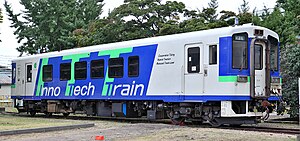KiHa 160
| KiHa 160 | |
|---|---|
 KiHa 160-1 as the "Inno Tech Train" in September 2010 | |
| In service | 1 June 1997 – 2013 |
| Manufacturer | Niigata Tekko |
| Constructed | 1997 |
| Refurbished | 2007 |
| Scrapped | 2013 |
| Number built | 1 vehicle |
| Number in service | None |
| Formation | Single car |
| Fleet numbers | KiHa 160-1 |
| Capacity | 110 (42 seated) |
| Operators | JR Hokkaido |
| Depots | Tomakomai |
| Lines served | Hidaka Main Line |
| Specifications | |
| Car body construction | Steel |
| Car length | 18,500 mm (60 ft 8 in) |
| Width | 2,700 mm (8 ft 10 in) |
| Height | 3,620 mm (11 ft 11 in) |
| Doors | 2 sliding doors per side |
| Maximum speed | 110 km/h (70 mph) |
| Weight | 32.5 t |
| Prime mover(s) | N-DMF13HZ |
| Power output | 330 hp (250 kW) |
| Transmission | Hydraulic |
| Bogies | N-DT150 (motored), N-TR150 (trailer) |
| Multiple working | KiHa 130 |
| Track gauge | 1,067 mm (3 ft 6 in) |
The KiHa 160 (キハ160
Design
[edit]The design was based on the Tsugaru Railway 21 series DMU built to Niigata's "NDC" lightweight design.[2] As with the KiHa 150-100 cars, the Kiha 160 had inward-opening hopper windows.[3]
When delivered, the unit was originally painted in a similar livery to the KiHa 150-0 units, with light green doors, a light green waistline band, and light purple stripes.[4] From September 1999, it was repainted into a new livery similar to the KiHa 40-350 DMUs transferred to the Hidaka Line on which the KiHa 160 was used.[2]
Internally, the car had fixed 2+1 facing transverse seating bays, with longitudinal bench seating next to the doorways.[3]
-
A JR Hokkaido KiHa 150-100 series DMU car in September 2008, showing the same livery as initially carried by Kiha 160-1
-
KiHa 160-1 at Tomakomai Station in revised livery before rebuilding
History
[edit]KiHa 160-1 entered revenue service on the Hidaka Main Line on 1 June 1997, used interchangeably with the KiHa 130 DMUs also used on the line.[3]
In 2007, the unit was rebuilt as an experimental hybrid vehicle using a motor-assisted hybrid system. At the same time, the longitudinal bench seating was replaced with limited-express style transverse seating.[2]
Following the completion of testing, the unit was placed in storage at Naebo Works,[2] before being officially withdrawn in fiscal 2013.[5]
References
[edit]- ^ Jēāru zensharyō handobukku: Rail Magazine 2009 JR
全 車輌 ハンドブック2009 [JR Rolling Stock Handbook 2009]. Japan: Neko Publishing. 2009. p. 473. ISBN 978-4-7770-0836-0. - ^ a b c d Nishiwaki, Kōji (October 2011). JR
各社 の新 世代 気動車 の現状 JR北海道 キハ160形 JR東日本 キハE200形 [The Current Situation of JR Group Modern DMUs: JR Hokkaido KiHa 160 & JR East KiHa E200]. Japan Railfan Magazine. Vol. 51, no. 606. Japan: Koyusha Co., Ltd. pp. 96–101. - ^ a b c
日本 と世界 の鉄道 カタログ'97~'98 [Japan and World Railway Catalogue 1997–1998] (in Japanese). Japan: Seibido Publishing. 17 August 1997. pp. 58–59. ISBN 978-4-415-09254-6. - ^ JR
全 車輛 ハンドブック1997 [JR Rolling Stock Handbook 1997]. Japan: Neko Publishing. 1997. p. 360. - ^ Tezuka, Kazuyuki (July 2014).
車両 のうごき2013-2014 [Rolling stock changes (2013–2014)]. Japan Railfan Magazine (in Japanese). Vol. 54, no. 639. Japan: Koyusha Co., Ltd. p. 70.
External links
[edit]- JR Hokkaido KiHa 160 (Japan Railfan Magazine) (in Japanese)



